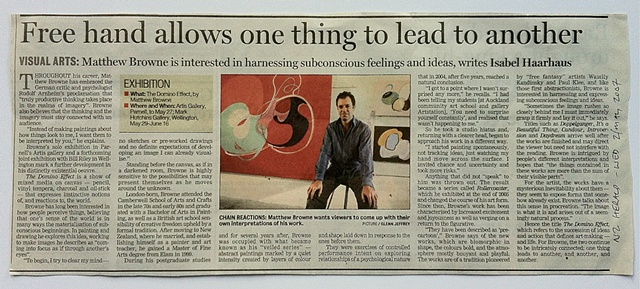Features
Isabel Haarhaus - The New Zealand Herald - Arts - Features - 22//05/2007
______________________________
Matthew Browne wants viewers to come up with their own interpretations of his work.
Throughout his career, Matthew Browne has embraced the German critic and psychologist Rudolf Arnheim and his proclamation that "Truly productive thinking takes place in the realms of imagery". Browne also believes that the thinking and the imagery must stay connected with an audience.
"Instead of making paintings about how things look to me, I want them to be interpreted by you," he explains.
Browne's solo exhibition in Parnell's Artis Gallery and a forthcoming joint exhibition with Bill Riley in Wellington mark a further development in his distinctly existential oeuvre.
'The Domino Effect' is a show of mixed media on canvas - pencil, vinyl tempera, charcoal and oil-stick - that expresses instinctive notions of, and reactions to, the world.
Browne has long been interested in how people perceive things, believing that one's sense of the world is in many ways the materialisation of subconscious beginnings. In painting and drawing he explores this idea, working to make images he describes as "coming into focus as if through another's eyes".
"To begin, I try to clear my mind - no sketches or pre-worked drawings and no definite expectations of developing an image I can already visualise."
Standing before the canvas, as if in a darkened room, Browne is highly sensitive to the possibilities that may present themselves as he moves around the unknown.
London-born, Browne attended the Camberwell College of Arts in the late 70s and early 80s and graduated with a Bachelor of Arts in Painting, as well as a British art school sensibility of creative freedom upheld by a formal tradition. After moving to New Zealand, where he married, and establishing himself as a painter and art teacher, he gained a Master of Fine Arts degree from Elam School of Fine Art in 1999.
During his postgraduate studies and for several years after, Browne was occupied with what became known as his 'veiled series' - abstract paintings marked by a quiet intensity created by layers of colour and shape laid down in response to the ones before them. They were exercises of controlled performance intent on exploring relationships of a psychological nature that in 2004, after five years, reached a natural conclusion.
"I got to a point where I wasn't surprised any more," he recalls. "I had been telling my students at Artstation, 'You need to surprise yourself constantly', and realised that wasn't happening for me."
So he took a studio hiatus and, returning with a clearer head, began to approach his work in a different way.
"I started painting spontaneously, not tracking ideas, just watching my hand move across the surface. I invited chance and uncertainty and took more risks."
Anything that did not "speak" to him was thrown out. The result became a series called 'Rollercoaster', which he exhibited at the end of 2005 and changed the course of his art form.
Since then, Browne's work has been characterised by increased excitement and joyousness as well as verging on a return to the figurative.
"They have been described as 'pre-cartoon'," Browne says of the new works, which are biomorphic in shape, the colours bold, and the atmosphere mostly buoyant and playful.
The works are of a tradition pioneered by "free fantasy" artists Wassily Kandinsky and Paul Klee and like those first abstractionists, Browne is interested in harnessing and expressing subconscious feelings and ideas.
"Sometimes the image rushes so closely behind me I must immediately grasp it firmly and lay it out," he says.
Titles such as Doppelganger, It's a Beautiful Thing, Candour, Introversion and Daydream arrive well after the works are finished and may direct the viewer but need not interfere with the reading. Browne is intrigued by people's different interpretations and hopes that "the things contained in these works are more than the sum of their visible parts".
For the artist, the works have a mysterious inevitability about them - they seem to expose forms that somehow already exist. Browne talks about this sense in procreation. "The image is what it is and arises out of a seemingly natural process."
Hence the title 'The Domino Effect', which refers to the succession of ideas and action that defines art-making - and life.
For Browne, the two continue to be intricately connected: one thing leads to another, and another, and another.
[Like]
Exhibition: 'The Domino Effect', by Matthew Browne
Where and When: Artis Gallery, Auckland to May 27; Mark Hutchins Gallery, Wellington, May 29-June 16
